Fruit and vegetables
Key points about fruit and vegetables
- Fruit and vegetables are an important part of a healthy diet.
- Eat a wide range of different coloured fruits and vegetables to get a variety of vitamins, minerals and dietary fibre in your diet.
- Whole, canned or frozen fruits and vegetables are close to how they are found in nature which makes them the best options.
- The daily recommended amount depends on your age, sex and other factors such as whether you're breastfeeding.
- If you're not eating enough fruit and vegetables, making small changes by adding more to your day can improve your diet and health.
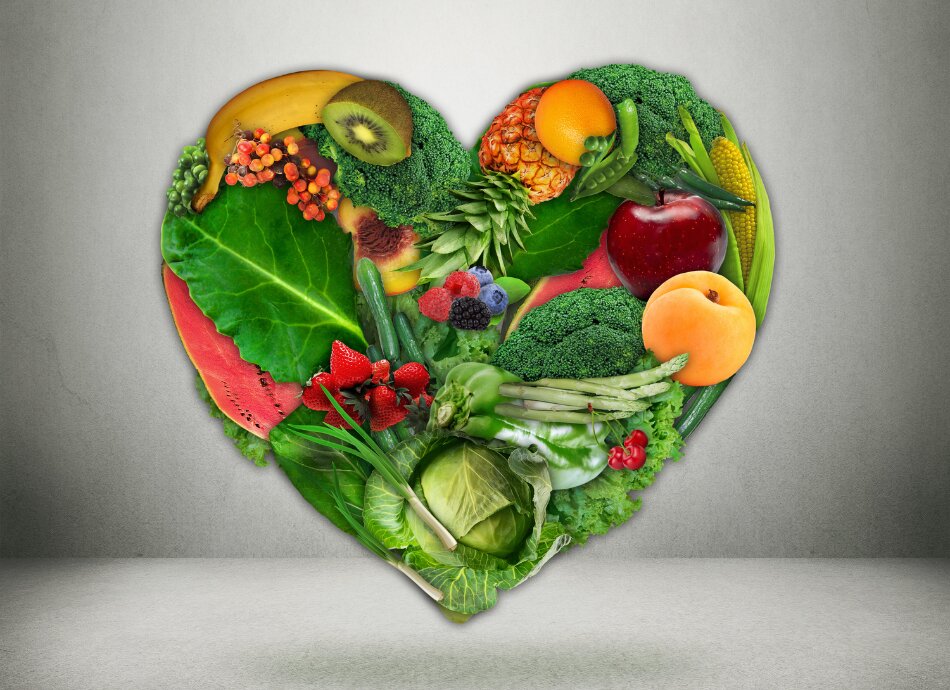
Fruit and vegetables are an important part of a healthy diet. They provide essential nutrients you need to stay healthy, such as dietary fibre, vitamins and minerals. They also contain antioxidants and polyphenols which protect your health.
Whole, canned or frozen fruits and vegetables are the least processed options and closest to how they're found in nature. Juice and dried fruit lack fibre and are high in sugar.
Choosing a rainbow of colours each day (eg, red, blue, orange, white, purple, yellow and green) is important for you to get a range of nutrients.
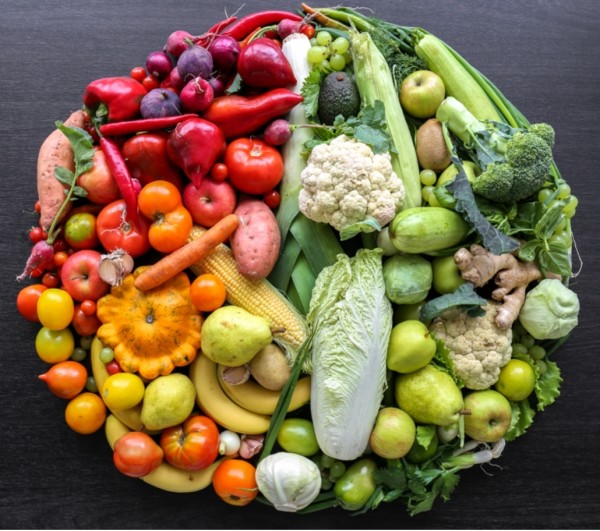
Image credit: Freepik
Eating fruit and vegetables daily is essential for:
- healthy growth and development
- supporting a strong immune system
- supporting digestion and a healthy gut
- maintaining a healthy body weight
- reducing your risk of health conditions such a diabetes, heart disease and some types of cancer.
It's great to eat with the seasons and it can also cost less. Find out what's available at this time of year(external link) on the 5+ a day website.
Fruit
A serving of fruit is about:
- 1 medium sized orange, banana, pear or apple
- 2 small kiwifruit, plums or apricots
- 1 cup of diced or canned fruit, such as peaches or pineapple – drained with no added sugar
- I cup of frozen fruit, such as berries or mango.
Vegetables
A serving of vegetables is about:
- 1/2 cup of cooked vegetables such as carrot, broccoli, bok choy, pūha, watercress, silverbeet, spinach, kamokamo (squash), cabbage or taro leaves
- 1/2 cup of canned vegetables, such as corn, beetroot or tomato
- 1 cup of leafy greens or raw salad vegetables
- 1/2 a medium sized potato, or similar sized piece of kūmara, taewa (Māori potato), yam (Pacific or New Zealand), taro, cassava or green banana
- 1 medium sized tomato.
Below is the number of servings of fruit and vegetables recommended each day according to your age, sex, or life stage. Extra servings might be needed for taller or more active adults.
Daily servings for different ages
- 1 to 2 years: 2 to 3 servings of vegetables and 1/2 serving of fruit.
- 2 to 3 years: At least 2.5 servings of vegetables and at least 1 serving of fruit.
- 4 to 8 years: At least 4.5 servings of vegetables and at least 1.5 servings of fruit.
- 9 to 11 years: At least 5 servings of vegetables and at least 2 servings of fruit.
- 12 to 18 years – boys: At least 5.5 servings of vegetables and at least 2 servings of fruit.
- 12 to 18 years – girls: At least 5 servings of vegetables and at least 2 servings of fruit.
- Adult men (19 to 50 years): At least 6 servings of vegetables and 2 servings of fruit.
- Adult men (51 to 70 years): At least 5.5 servings of vegetables and 2 servings of fruit.
- Adult men (70+): At least 5 servings of vegetables and 2 servings of fruit.
- Adult women not breastfeeding (19+): At least 5 servings of vegetables and 2 servings of fruit.
- Breastfeeding women: At least 7.5 servings of vegetables and 2 servings of fruit.
Enjoy the goodness of fruit and vegetables in your meals and as a healthy snack.
Here are some easy ways to add more fruit and vegetables into your diet:
Breakfast
- Add chopped fresh fruit or drained canned fruit (in juice) to your breakfast cereal.
- Try chopped banana or grated apple in your porridge. Peaches, berries and kiwifruit when in season add colour and variety.
- Add tomatoes and mushrooms to scrambled or poached eggs.
Lunch
- Use salad fillings to bulk out lunches.
- Use up leftover roast vegetables by adding to a salad for lunch, eg, with some spinach leaves, chopped tomatoes and canned lentils or chickpeas to add protein.
Snacks
- Keep a bowl of fresh fruit on the bench or kitchen table.
- Cut up orange and apple slices for snacks on the run.
- Try freezing banana slices or grapes for a yummy treat – note that frozen grapes aren't suitable for children.
- Try fruit with yoghurt and a sprinkle of nuts.
- Cut up celery, cucumber and carrot sticks to eat with hummus.
Dinner
- Make vegetables the main event and add your protein and grain foods as a side.
- Soups and stews are a great way to use vegetables that are about to go out of date.
- Add grated or finely chopped vegetables to dishes such as bolognaise sauce, meatballs or meatloaf.
- When introducing unfamiliar and new vegetables at dinner time, try serving them with a familiar food your tamariki enjoys.
Use the healthy plate model as a guide to help you serve up vegetables for lunch and dinner meals.
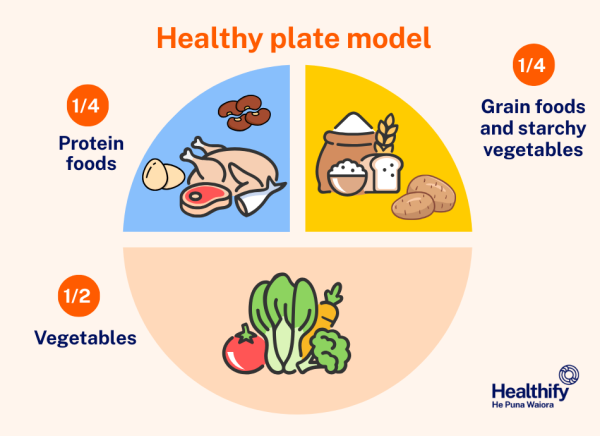
Image credit: Healthify He Puna Waiora
There are lots of ways to encourage your whānau to enjoy fruit and vegetables. The most important thing is to avoid pressure to eat a certain food or finish what is on their plate.
Here are some ideas
- Grow fruit and veggies at home: You don't need a lot of space – even a few pots on the windowsill or doorstep can give you fresh strawberries, cherry tomatoes or salad greens. Children love watching them grow. .
- Model healthy eating: If kids see you enjoying fruit and vegetables, they'll be more likely to try them too.
- Keep trying: Young children may need 10 to 15 times (or more) attempts before they accept a new food. Offer without pressure, avoid forcing, and simply try again another time. Some foods take time to enjoy, and some kids may just not like certain ones – and that’s okay.
- Involve children: Get them helping with preparing meals, school lunches and snacks. It’s a fun way to show them how fruit and veggies can be added to food in tasty and enjoyable ways.
- Be organised: Keep pre-cut fruit and vegetables in the fridge and stock up on frozen and canned options for quick meals. Choose canned products without added sugar or salt where possible.
- Visit 5 + A Day(external link) for some good parenting tips, snack and lunchbox ideas.
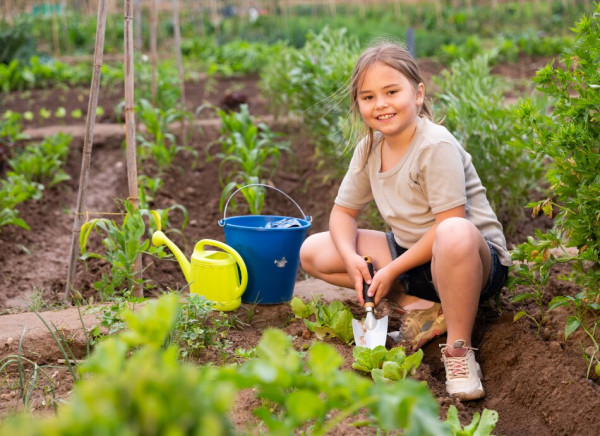
Image credit: Canva
The average New Zealander throws away 3 supermarket trolleys of perfectly good food each year. No-one likes throwing away food – especially when you've planned a meal or are sticking to a budget.
Here are some easy tips for keeping your fruit and vegetables fresh for longer
- Keep carrots fresh in the fridge by storing them in a container with a wet paper towel.
- Don’t store apples, bananas, pears and potatoes together – they release gases that speed up the ripening process.
- Store ripe fruit in the fridge or freezer to extend freshness.
- Revive limp celery or broccoli by trimming the base and standing it in water for a few hours.
- Keep salad leaves fresh in an airtight container.
- Chop onions, broccoli, cauliflower and spring onions, then freeze until needed.
- Wrap damp towels around the base of asparagus or soft herbs (eg, coriander, parsley and mint) and store upright in a glass of water.
- Store potatoes in a cool, dark place away from onions.
- Store leftover cut fruit or vegetables in a beeswax wrap or airtight container.
Visit Love Food Hate Waste(external link) for more tips on reducing your household's food waste.
Fruit and vegetable facts(external link) 5+ A Day Foundation, NZ
How to get 5+ a day every day(external link) 5+ A Day Foundation, NZ
Easy choice meal planner and family kai cook book(external link) Love Food Hate Waste, NZ
Reduce your waste(external link) Love Food Hate Waste, NZ
Eating with diabetes(external link) Diabetes New Zealand
Healthy eating for a healthy heart(external link) Heart Foundation, NZ
Healthy eating kids(external link) Heart Foundation, NZ
Reduce waste save money(external link) Love Food Hate Waste
Brochures
Healthy heart visual food guide poster(external link) Heart Foundation, NZ
Food portions(external link) Heart Foundation, NZ
Eating and activity guidelines for adults(external link) Health New Zealand | Te Whatu Ora, NZ, 2020
Eating and activity guidelines for New Zealand adults – summary of guidelines statements and key related information(external link) MOH, NZ, 2021
Apps
Nutrition apps
Nutrition apps – children
Nutrition, exercise and weight management apps
References
- Eating and activity guidelines for adults(external link) Ministry of Health, NZ, 2020
- Eating and activity guidelines for babies and toddlers(external link) Ministry of Health, NZ, 2021
- A-Z storage guide(external link) Love Food Hate Waste, NZ
- Summary report: Food loss and waste in Aotearoa New Zealand – towards a 50% reduction(external link) OPMSCA, NZ, 2024
Brochures
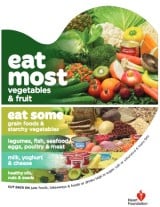
Healthy heart visual food guide poster
Heart Foundation, NZ
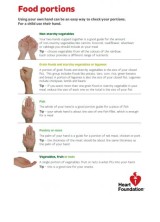
Food portions Heart Foundation, NZ
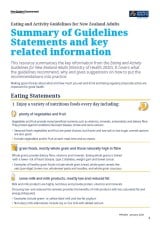
Eating and activity guidelines for adults (summary)
Ministry of Health, NZ, 2021
Credits: Healthify editorial team. Healthify is brought to you by Health Navigator Charitable Trust.
Reviewed by: Lily Henderson, Registered Dietitian; Emma Mcmichael, Registered Dietitian, Tauranga
Last reviewed:





